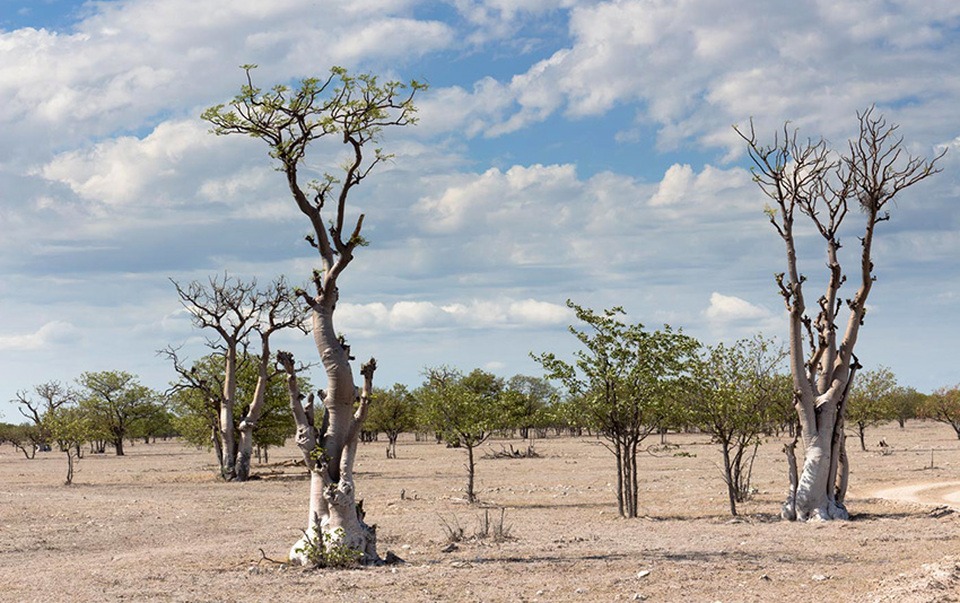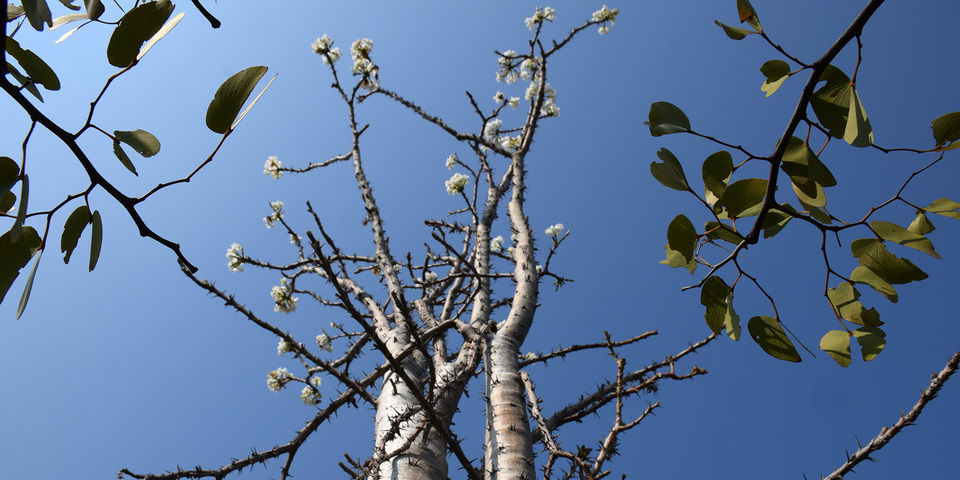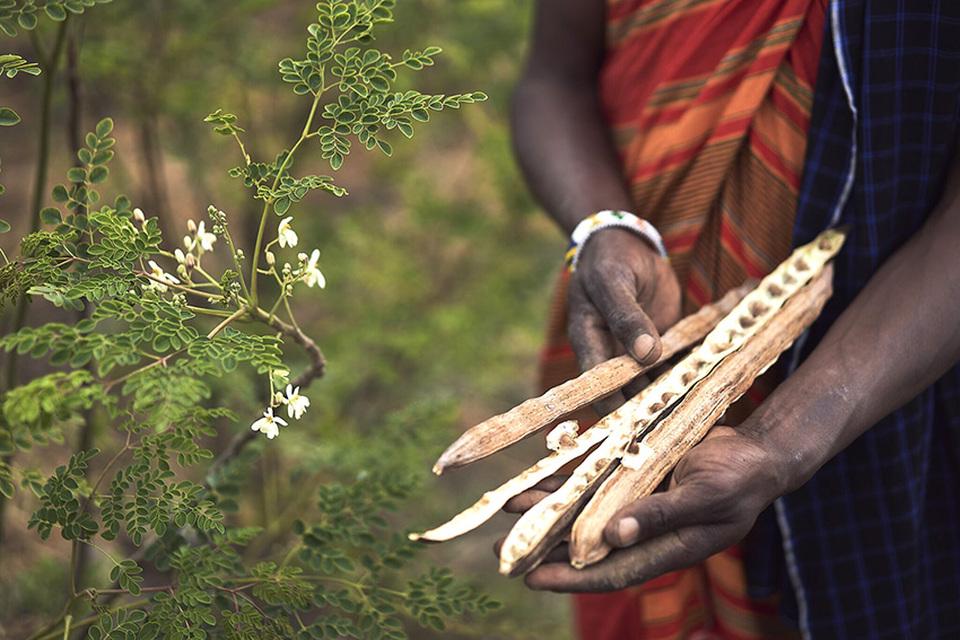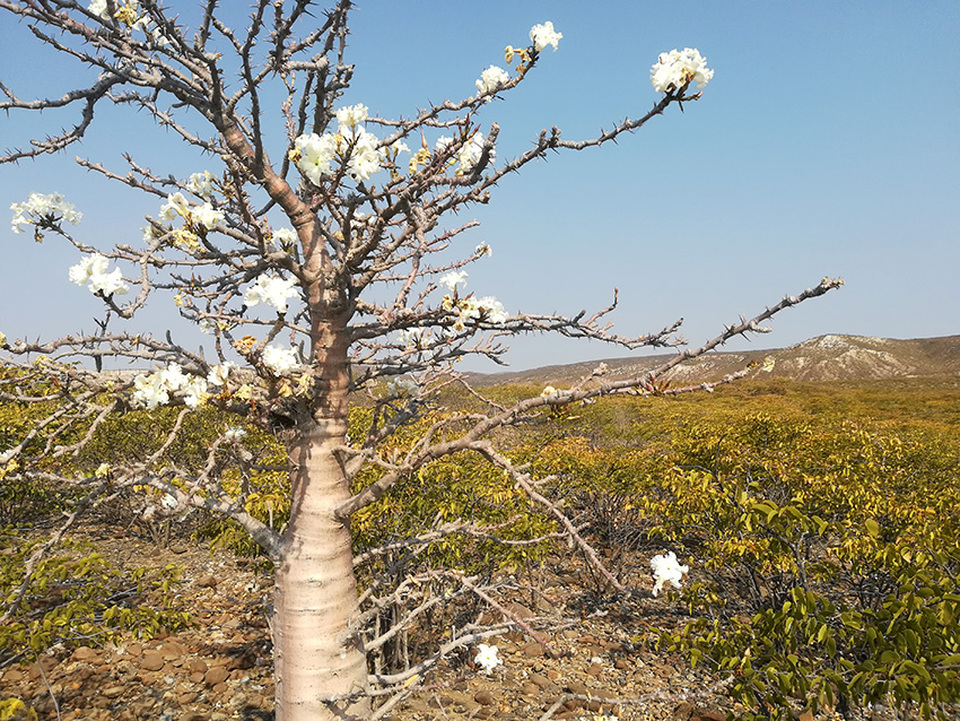It looks like a phantom and there is a whole forest of them in the Etosha National Park; when their seeds ripen and the pods burst open, it makes quite a loud pop: but the Moringa tree can do even more, for its medicinal benefits are immense. It is not for nothing that it is also called the “tree of life”. Almost all parts of the tree can be used for traditional medicine.

The Moringa Is a Tree Full Of Wonders

A Bottle Tree in Damaraland in North-western Namibia. Photo: Gondwana Collection
The Moringa tree, also known as the horseradish tree, has been known in India for about 5,000 years and has spread from there across the Arabian Peninsula to East Africa, south western Africa and as far as Madagascar. The roots taste like radish when raw due to the mustard oil glycosides they contain.

The delicate flowers of the Moringa olifeira. Photo: Harvey McDaniel
The British colonialists are said to have used the Moringa in India as a substitute for radish and mustard in their meals, thus contributing to its faster spread to other colonies, including Africa, as it grows well in other climates.
A short botanical excursion
In India, the tree is known as “murinna”, from where the botanical name is derived from. The Moringa is the only plant genus of the mono-generic family of the ben-nut family (Moringaceae). There are only thirteen species of Moringa in the world and two grow in Namibia: Moringa oleifera and ovalifolia, the latter has oval leaves and is more commonly known as the phantom or ghost tree. In the west of the Etosha National Park there is the famous “Sprokieswoud” (Fairy tale forest) with very tall, old Moringa ovalifolia trees.

Big Moringa ovalifolia Trees in „Sprokieswoud“ in Etosha National Park. Photo: Wikipedia
In rocky areas in the southern and north-westerns part of Namibia, one comes across stately specimens of Moringa ovalifolia, also known as the bottle tree.
Tree of life
Both Moringa species have adapted well to the climatic conditions of Namibia and get by with very little rain. However, the Moringa olifeira grows faster and is easy to grow from seeds. The sustainably harvested leaves can be dried as a powder and processed in capsules for oral use. According to numerous international studies, the leaves of olifeira contain much more vitamin C than,, oranges, for example.

Beautiful flowers on a Moringa Tree. Photo: Gondwana Collection
The Moringa olifeira is said to contain a lot of vitamins, minerals and trace elements.
This has also been recognised in Namibia in recent years, and various Moringa products from Namibian trees, including tea and juice, can now be bought in the health food departments of shops throughout the country.

Leaves, flowers and seeds of the Moringa olifeira. Photo by: Fabian Vogt
For some farmers and smallholders, this profitable niche market with its certified Moringa products has now become an important additional income.
In the Kavango East region, the income from a Moringa plantation on two hectares planted with German subsidies, finances the costs for an orphanage. The plantation of the Theresia Foundation for orphans and needy children is also a small training center for rural people to encourage them to plant Moringa trees in their homesteads.
The seeds contain a high proportion of valuable vegetable oils, which are also used in natural cosmetics and soap production. Behene oil used to be important, and interestingly watchmakers used it in the past as a lubricant in watches.

Many Moringa Trees grow at the Epupa Falls. Photo: Gondwana Collection
The seeds, when ground, can also disinfect and purify water. Various scientific studies have proven this.
The bottle tree (Moringa ovalifolia)
The second Moringa species found in Namibia, ovalifolia, has different characteristics. Striking is the tall succulent-like white trunk, like a bottle in the dry desert and semi-desert areas of Namibia. This tree species grows on rocky, steep slopes. The smooth and resinous bark reflects sunlight and protects the tree’s interior, and the water stored there from overheating. The stored water allows the tree to survive periods of drought.
The Namibian indigenous people, the San, used to carefully drill into the trunks of these trees and drink small amounts of the water. They carefully sealed the small holes. They also knew that if all the water was sucked out, the trees would die.

A big Moringa ovalifola in North-Western Namibia. Photo: Violet Gottrop
The oval leaves are “bipinnate” each having up to seven pairs of oval leaflets and one terminal leaflet. The leaflets can grow up to 25 mm long.
The flowers, which are also white, are arranged in panicles, which later develop into grey-brown, triangular, long pods that split along three flaps and also release the winged seeds with popping noises.
This tree species is said to have little medicinal use compared to olifeira.
The Moringa ovalifolia is protected in Namibia by a nature conservation ordinance.

A Moringa ovalifolia in bloom. Photo: Gondwana Collection
At the Epupa Falls on the Kunene River, there are magnificent, tall specimens of Moringa ovalifolia on the rocky island. On the drive to Epupa, one finds that this Moringa species likes to grow near baobab trees.
It is well worth taking a closer look at Namibia’s Moringa trees and making a brief stop on your journey through the country to take a closer look at them.
Brigitte Weidlich
Article published with the permission of Gondwana collection Namibia

Copyright 2023 | All Rights Reserved | Powered by WILD & JAG / GAME & HUNT


